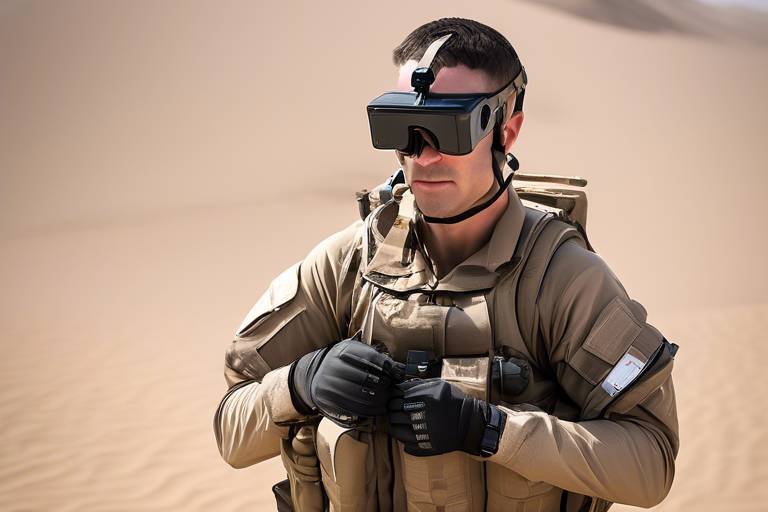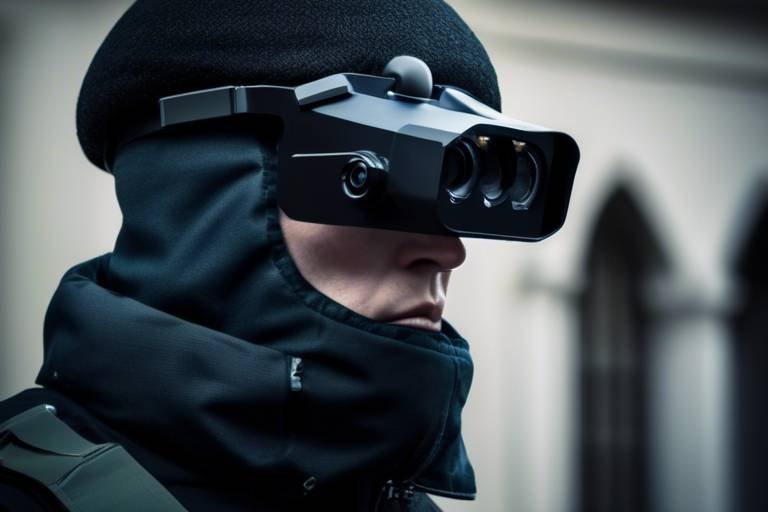How Wearable Devices Enhance Data Collection in the Field
The advent of wearable technology has revolutionized how data is collected across various fields, creating a seismic shift in research methodologies and operational practices. Imagine strapping on a device that not only tracks your movements but also gathers critical health metrics in real-time. This is the reality that wearable devices bring to the table, transforming mundane data collection into a dynamic and engaging process. Whether in healthcare, environmental research, or sports analytics, these devices are enhancing the way we gather, analyze, and interpret data, making it more accessible and efficient.
Wearable devices come in many forms—from smartwatches and fitness trackers to more specialized equipment like health monitors and environmental sensors. Each of these devices is equipped with sensors that collect a variety of data, such as heart rate, temperature, and even geographical location. This data can be transmitted instantly to researchers or healthcare providers, providing a wealth of information that was previously difficult to obtain. The implications of this technology are profound, as it allows for a more nuanced understanding of behaviors and conditions in real-time.
One of the standout features of wearable devices is their ability to collect data in natural settings. This is particularly beneficial in fields such as healthcare and environmental science, where understanding the context in which data is collected can significantly enhance its value. For instance, a wearable device can monitor a patient's vital signs throughout their daily activities, offering insights into how lifestyle factors affect health. Similarly, environmental sensors can gather data on air quality or temperature variations in real-time, allowing researchers to observe patterns that might otherwise go unnoticed.
Moreover, the integration of wearable devices into research methodologies is not just about data collection; it's also about improving the accuracy and reliability of that data. Traditional methods often rely on self-reported data, which can be skewed by personal bias or misunderstanding. Wearables eliminate these variables by providing objective measurements. This leads to more reliable data, which is crucial for making informed decisions in healthcare, policy-making, and scientific research.
As we look to the future, the potential of wearable devices in enhancing data collection is boundless. Innovations such as improved battery life, advanced sensors, and AI-driven analytics are on the horizon, promising to make these devices even more effective. Imagine a world where your wearable not only tracks your health metrics but also predicts potential health issues before they arise. This is the kind of future that researchers and developers are striving for, one where data collection is seamless, unobtrusive, and incredibly insightful.
- What types of data can wearable devices collect? Wearable devices can collect various types of data, including heart rate, step count, sleep patterns, temperature, and even location data.
- How do wearable devices improve data accuracy? By providing objective measurements and minimizing human error associated with self-reporting, wearable devices enhance the reliability of data collected.
- What are some challenges associated with wearable devices? Challenges include data privacy concerns, technological limitations, and the need for user education to ensure proper use and understanding of the devices.
- What is the future potential of wearable devices? The future holds exciting possibilities, including advancements in AI, longer battery life, and more sophisticated sensors that could revolutionize how we gather and interpret data.
Introduction to Wearable Technology
Wearable technology is not just a buzzword; it's a revolution that's reshaping how we interact with the world around us. Imagine strapping on a device that not only tracks your steps but also monitors your heart rate, sleep patterns, and even your stress levels. These devices are designed to be worn on the body, seamlessly integrating into our daily lives while collecting and transmitting data in real-time. The most common types of wearable devices include smartwatches, fitness trackers, smart glasses, and health monitoring devices. Each of these gadgets serves a unique purpose, catering to different needs and preferences.
The significance of wearable technology is growing rapidly across various sectors, from healthcare to sports, and even in industrial applications. In healthcare, for instance, wearables are transforming patient monitoring by allowing for continuous data collection outside of traditional clinical settings. This shift not only enhances patient outcomes but also empowers individuals to take control of their health. In sports, athletes are using wearable devices to optimize their performance, track their training metrics, and prevent injuries. The versatility of these devices is expanding, making them indispensable tools in our modern lives.
One of the most exciting aspects of wearable technology is its potential for data collection. Unlike traditional methods that often rely on manual input or periodic checks, wearables provide a continuous stream of data, enabling more accurate and comprehensive insights. As we delve deeper into this article, we will explore the various applications of wearable devices, particularly in healthcare and research methodologies, and how they are enhancing data collection and operational efficiency.
To illustrate the diversity of wearable technology, consider the following table that summarizes some popular types of devices and their primary functions:
| Device Type | Primary Function |
|---|---|
| Smartwatch | Tracks time, fitness metrics, and notifications |
| Fitness Tracker | Monitors physical activity, heart rate, and sleep |
| Smart Glasses | Displays information and records video hands-free |
| Health Monitor | Tracks vital signs and chronic disease parameters |
As we continue to explore the impact of wearable technology on data collection, it’s essential to recognize that these devices are more than just tech gadgets. They represent a shift towards a more connected and informed way of living. So, are you ready to dive into the world of wearables and discover how they can enhance your life and work?
Applications in Healthcare
Wearable devices have truly revolutionized the healthcare landscape, offering a plethora of benefits that extend beyond traditional monitoring methods. Imagine a world where patients can have their vital signs monitored in real-time, all while going about their daily lives. This is not just a futuristic dream; it's a reality made possible by the integration of wearable technology into healthcare practices. These devices, ranging from smartwatches to specialized health monitors, are designed to collect and transmit critical health data, enabling healthcare providers to make informed decisions quickly.
One of the most significant advantages of wearable technology in healthcare is its ability to facilitate remote health management. Patients with chronic conditions, such as diabetes or heart disease, can now be monitored continuously without the need for frequent visits to the doctor's office. This not only saves time but also reduces the burden on healthcare facilities. For instance, a diabetic patient can wear a continuous glucose monitor (CGM) that tracks their blood sugar levels throughout the day, sending alerts to both the patient and their healthcare provider if levels become dangerously high or low. This proactive approach can lead to better health outcomes and a more personalized care plan.
Moreover, wearable devices are not just limited to monitoring vital signs. They also play a crucial role in fitness tracking, which is essential for preventive healthcare. Devices like fitness trackers motivate users to maintain healthier lifestyles by providing personalized feedback based on their activity levels. For example, a smartwatch can remind you to stand up after prolonged sitting or encourage you to reach your daily step goals. This gamification of health encourages users to engage more actively in their wellness journey, ultimately leading to improved health.
To illustrate the impact of wearable devices in healthcare, consider the following table that summarizes key applications:
| Application | Description | Benefits |
|---|---|---|
| Real-time Monitoring | Continuous tracking of vital signs | Quick response to health changes |
| Remote Patient Management | Monitoring patients' health from a distance | Reduced hospital visits, personalized care |
| Fitness Tracking | Tracking physical activity and health metrics | Encourages healthier lifestyles |
| Chronic Disease Management | Assisting in the management of long-term conditions | Improved patient outcomes |
In addition to these applications, wearable devices also enhance communication between patients and healthcare providers. With the ability to share data instantly, doctors can make real-time adjustments to treatment plans based on the latest information. This not only fosters a more collaborative relationship between patients and providers but also empowers patients to take charge of their health. However, it's essential to acknowledge that while the benefits are significant, there are also challenges that come with the adoption of wearable technology in healthcare.
In summary, wearable devices are transforming healthcare by providing innovative solutions for monitoring and managing health conditions. As technology continues to advance, we can expect even more exciting developments that will further enhance the capabilities of these devices, making healthcare more accessible and efficient for everyone.
- What types of wearable devices are commonly used in healthcare?
Common wearable devices include fitness trackers, smartwatches, heart rate monitors, and continuous glucose monitors.
- How do wearable devices improve patient outcomes?
By enabling real-time monitoring and remote management, wearable devices help in early detection of health issues, leading to timely interventions and better health outcomes.
- Are there any privacy concerns associated with wearable technology?
Yes, data privacy is a significant concern. It's crucial for users to understand how their data is collected, stored, and shared.
Fitness Tracking
Fitness trackers have become a ubiquitous presence in our daily lives, and for good reason. These remarkable devices act as our personal health companions, constantly monitoring our physical activities and offering insights that can help us lead healthier lives. Imagine having a tiny coach strapped to your wrist, encouraging you to take that extra step or reminding you to get up from your desk after hours of sitting. It's not just about counting steps; it's about creating a holistic view of our health and wellness.
At their core, fitness trackers utilize advanced sensors to collect data on various metrics, including:
- Step Count: Tracking the number of steps taken throughout the day.
- Heart Rate Monitoring: Continuously measuring heart rate to gauge workout intensity.
- Calorie Tracking: Estimating calories burned based on activity levels.
- Sleep Tracking: Monitoring sleep patterns to enhance rest quality.
This information is then transmitted to a smartphone app or a web platform, where users can view their progress and set goals. The beauty of fitness tracking lies in its simplicity and accessibility. Whether you're a seasoned athlete or just starting your fitness journey, these devices cater to all levels of experience. They provide not only motivation but also accountability, helping users stay committed to their fitness objectives.
Moreover, many fitness trackers come equipped with personalized feedback mechanisms. For instance, if you've been inactive for a while, your device might vibrate, nudging you to move. This feature is particularly beneficial for those who struggle with sedentary lifestyles. It's like having a friend who gently reminds you to get moving, making the process feel less daunting.
In addition to motivation, fitness trackers can foster a sense of community. Many apps allow users to connect with friends and family, enabling them to share achievements, set challenges, and even compete in friendly competitions. This social aspect can significantly boost engagement and make fitness more enjoyable. After all, who wouldn’t want to challenge their friends to a step competition?
However, while fitness trackers offer numerous advantages, it's essential to approach them with a balanced mindset. They are tools designed to assist, not dictate. Users should remember that the numbers displayed on their devices are just one part of the overall picture of health. It's crucial to combine this data with a healthy diet, proper hydration, and mental well-being for a truly holistic approach to fitness.
In summary, fitness tracking devices are not just gadgets; they're powerful allies in our quest for better health. By providing real-time data, personalized feedback, and a community of support, these devices empower individuals to take charge of their fitness journeys. So, whether you're aiming to lose weight, build endurance, or simply stay active, a fitness tracker could be the perfect companion on your path to wellness.
Chronic Disease Management
In today's fast-paced world, managing chronic diseases can feel like an uphill battle. However, wearable devices are stepping in to change that narrative, offering innovative solutions that empower patients and healthcare providers alike. These devices, ranging from smartwatches to specialized health monitors, allow for continuous tracking of critical health metrics, making it easier for individuals to stay on top of their conditions.
Imagine a world where your health data is at your fingertips, quite literally! Wearable technology enables patients to monitor their vital signs, such as heart rate, blood glucose levels, and even oxygen saturation, in real time. This instant feedback not only helps in making informed decisions but also fosters a sense of ownership over one’s health. For instance, a diabetic patient can use a glucose monitor to check their blood sugar levels throughout the day, receiving alerts when levels are too high or too low. This kind of proactive management can significantly reduce the risk of complications.
Moreover, these devices facilitate better communication between patients and healthcare providers. With the ability to share data instantly, doctors can receive real-time updates on their patients' conditions without the need for frequent office visits. This is particularly beneficial for individuals with chronic diseases who may have mobility issues or live in remote areas. Telehealth, combined with wearable technology, creates a seamless experience that enhances patient care.
To illustrate the impact of wearables on chronic disease management, consider the following table that outlines key benefits:
| Benefit | Description |
|---|---|
| Real-Time Monitoring | Continuous tracking of vital signs allows for immediate intervention when necessary. |
| Data Sharing | Instantaneous sharing of health data with healthcare providers improves communication and care. |
| Patient Empowerment | Wearables encourage patients to take an active role in their health management. |
| Reduced Hospital Visits | Remote monitoring can decrease the need for in-person appointments, saving time and resources. |
In addition to these benefits, wearable devices also provide personalized insights and recommendations. Many devices come equipped with algorithms that analyze data trends and suggest lifestyle changes. For example, a heart monitor might prompt a user to engage in more physical activity if it detects a pattern of elevated heart rates. This level of personalization is crucial for managing chronic conditions, as it tailors health advice to the individual’s specific needs.
Despite these advantages, it's important to acknowledge that the integration of wearable technology into chronic disease management is not without challenges. Issues such as data privacy, device accuracy, and user adherence can affect the overall effectiveness of these tools. However, as technology continues to advance, solutions to these problems are being developed, paving the way for a future where chronic disease management is more efficient and accessible than ever before.
- How do wearable devices help in managing chronic diseases? Wearable devices provide real-time monitoring, data sharing, and personalized insights, enabling better management of chronic conditions.
- What types of chronic diseases can be managed with wearables? Common chronic diseases include diabetes, heart disease, asthma, and hypertension, all of which can benefit from wearable technology.
- Are wearable devices accurate? While most devices are designed for accuracy, it's important to choose reputable brands and understand that they should complement, not replace, professional medical advice.
- Can wearables replace traditional healthcare? Wearable devices enhance healthcare but do not replace the need for professional medical consultations and treatments.
Impact on Research Methodologies
Wearable devices are not just trendy gadgets; they are revolutionizing the way research is conducted across various fields. Imagine being able to gather data in real-time, right from the source, without the traditional barriers that often hinder research efforts. This is precisely what wearable technology offers. Researchers can now capture data in natural settings, leading to more authentic insights and outcomes.
One of the most significant advantages of using wearables in research is the real-time data collection capability. Instead of relying on self-reported data, which can often be biased or inaccurate, researchers can gather objective data directly from the device. For instance, in a study examining physical activity levels, a researcher can obtain continuous heart rate, step count, and even sleep patterns from participants wearing fitness trackers. This approach not only enhances the validity of the research findings but also allows for immediate adjustments to study protocols based on the data being collected.
Furthermore, the unobtrusive nature of wearable devices means that researchers can observe participants in their natural environments without disrupting their daily routines. This is particularly important in fields like psychology and sociology, where the presence of an observer can alter behavior. By employing wearables, researchers can collect data that more accurately reflects real-world conditions, leading to richer, more nuanced insights.
Another critical aspect of wearables is their ability to improve data accuracy and reliability. Traditional methods of data collection often involve manual entry, which can introduce human error. With wearables, data is captured automatically, significantly reducing the risk of mistakes. This automated process not only streamlines data management but also enhances the quality of research findings. For example, a study on sleep patterns can utilize wearable devices to track sleep stages and disturbances, providing researchers with precise metrics that would be challenging to obtain through subjective reports.
However, it's essential to acknowledge that while wearable devices offer numerous benefits, they also come with challenges. Data privacy is a significant concern, as sensitive information is being collected and transmitted. Researchers must ensure that they have robust protocols in place to protect participant data, thereby maintaining trust and integrity in their studies. Moreover, the technological limitations of wearables, such as battery life and sensor accuracy, can impact data collection processes. Addressing these challenges is crucial for maximizing the potential of wearable technology in research methodologies.
In summary, the integration of wearable devices into research methodologies is transforming the landscape of data collection. By enabling real-time, accurate, and unobtrusive data gathering, these technologies are paving the way for more reliable and insightful research outcomes. As researchers continue to explore the capabilities of wearables, we can expect to see even more innovative applications that enhance our understanding of various phenomena.
- What are wearable devices? Wearable devices are electronic gadgets that can be worn on the body, capable of collecting and transmitting data.
- How do wearables improve research methodologies? They enable real-time data collection, reduce human error, and allow for unobtrusive observation in natural settings.
- What challenges do wearable devices face in research? Data privacy concerns and technological limitations, such as battery life and sensor accuracy, are significant challenges.
- Are wearables reliable for data collection? Yes, wearable devices can enhance data accuracy and reliability by automating data capture and minimizing human error.
Field Studies
In the realm of research, have traditionally relied on manual data collection methods, which can be both time-consuming and prone to error. However, the introduction of wearable devices has revolutionized this landscape, allowing researchers to gather data in real-time and in natural settings. Imagine being able to observe participants in their everyday environments while effortlessly collecting vital data points without interrupting their routines. This is precisely what wearable technology enables.
Wearable devices, such as smartwatches and fitness trackers, are equipped with sensors that can monitor a variety of metrics, including heart rate, movement patterns, and even environmental factors like temperature and humidity. By utilizing these devices, researchers can collect data that is not only accurate but also reflective of real-world conditions. This unobtrusive data collection method enhances the validity of research findings, as participants are less likely to alter their behavior when they are not aware of being observed.
Consider a study examining the physical activity levels of schoolchildren. Instead of relying on self-reported data, which can be biased or inaccurate, researchers can equip students with wearable devices that track their activity throughout the day. The data collected provides a comprehensive view of the children's movement patterns, allowing researchers to draw more reliable conclusions about their physical activity levels.
Moreover, the integration of wearable devices in field studies allows for the collection of longitudinal data, which is essential for understanding trends over time. For instance, researchers studying the effects of a new intervention on health outcomes can continuously monitor participants' vital signs and activity levels, providing a rich dataset that reveals how these factors change over weeks or months. This capability not only enhances the depth of research but also facilitates a more dynamic understanding of the subjects being studied.
However, while the benefits are substantial, it’s essential to consider the ethical implications of using wearable technology in research. Issues surrounding data privacy and consent must be addressed to ensure that participants feel safe and secure while their data is being collected. Researchers must be transparent about how the data will be used and take measures to protect participants' identities.
In summary, wearable devices are transforming field studies by providing researchers with the tools to collect accurate, real-time data in natural settings. This shift not only improves the quality of research findings but also opens new avenues for understanding human behavior and health. As technology continues to evolve, the potential for wearable devices in research will only expand, leading to even more innovative methodologies and insights.
- What types of wearable devices are commonly used in field studies?
Common wearable devices include smartwatches, fitness trackers, and specialized sensors that monitor physiological metrics.
- How do wearable devices improve data accuracy?
Wearable devices minimize human error by collecting data automatically and continuously, reducing reliance on self-reported information.
- Are there privacy concerns associated with wearable devices?
Yes, data privacy is a significant concern. Researchers must ensure that participants' data is anonymized and securely stored.
- Can wearable devices be used in all types of research?
While wearable devices are highly versatile, their applicability depends on the research context and the specific data being collected.
Data Accuracy and Reliability
When it comes to research, the integrity of data is paramount. Wearable devices have emerged as a game changer in this arena, significantly enhancing data accuracy and reliability. Traditional methods of data collection often involve manual input, which is prone to human error. Imagine trying to track your daily steps with a pen and paper—it's not only tedious but also leaves room for mistakes. Wearables, on the other hand, automate this process, ensuring that the data collected is as precise as possible.
One of the most remarkable features of wearable technology is its ability to provide real-time data. For instance, a smartwatch can continuously monitor heart rates, activity levels, and even sleep patterns without any input from the user. This continuous stream of data helps in creating a more accurate picture of an individual's health or behavior over time. In the context of research, this means that data can be gathered in a more consistent and reliable manner, reducing the chances of discrepancies that often arise from sporadic data collection methods.
Furthermore, the integration of advanced sensors in wearable devices enhances their capability to capture nuanced data. For example, consider how fitness trackers measure not just steps taken but also the intensity of the activity. This level of detail is invaluable for researchers who need to analyze the impact of physical activity on health outcomes. The precision of such measurements allows for more robust conclusions, ultimately leading to better-informed decisions in both healthcare and scientific research.
However, it’s essential to acknowledge that while wearable devices greatly improve data accuracy, they are not without their challenges. For instance, the reliability of the data can be affected by factors such as device calibration, user compliance, and environmental conditions. To address these concerns, researchers often implement standardization protocols to ensure that data is collected uniformly across different devices and settings. Here’s a simple table illustrating some of the factors influencing data accuracy:
| Factor | Impact on Data Accuracy |
|---|---|
| Device Calibration | Ensures measurements are consistent and accurate. |
| User Compliance | Non-compliance can lead to incomplete or biased data. |
| Environmental Conditions | Extreme conditions can affect sensor performance. |
In conclusion, while wearable devices offer a revolutionary approach to data collection with significant improvements in accuracy and reliability, it’s crucial for researchers and users alike to remain aware of the potential challenges. By understanding these factors and implementing best practices, the full potential of wearables can be harnessed, paving the way for groundbreaking research and advancements in various fields.
- What types of data can wearable devices collect? Wearable devices can collect a variety of data including heart rate, steps taken, sleep patterns, and even blood oxygen levels.
- How do wearables improve data accuracy? They automate data collection, reducing human error and providing real-time, continuous monitoring.
- What challenges do researchers face with wearable technology? Challenges include device calibration, user compliance, and environmental factors that may affect data collection.
- Are wearable devices reliable for long-term studies? Yes, when used correctly, they can provide consistent and reliable data over extended periods.
Challenges and Limitations
While the rise of wearable devices has ushered in a new era of data collection, it is crucial to acknowledge the that accompany this technological revolution. These devices, despite their numerous advantages, face several hurdles that can impact user experience, data integrity, and overall adoption rates. Understanding these challenges is essential for both developers and users alike.
One of the primary concerns surrounding wearable devices is data privacy. As these gadgets continuously collect sensitive information, users often worry about who has access to their data and how it is being utilized. For instance, fitness trackers monitor heart rates, sleep patterns, and even location data, which raises significant privacy issues. In a world where data breaches are not uncommon, users may hesitate to embrace wearable technology fully. According to a recent study, approximately 60% of potential users express concerns about data misuse, which can hinder the widespread adoption of these devices.
Another challenge is the technological limitations inherent in many wearable devices. While advancements in technology have led to improved functionality, some devices still struggle with battery life, connectivity issues, and the accuracy of the data collected. For example, a smartwatch may only last a day on a single charge, requiring frequent recharging, which can be inconvenient for users. Moreover, the accuracy of sensors can vary significantly, leading to potential discrepancies in the data collected. This inconsistency can undermine the reliability of the information, particularly in critical applications such as healthcare.
Additionally, the user experience plays a pivotal role in the adoption of wearable devices. Many users find the interfaces of these devices to be complex or unintuitive, making it challenging for them to navigate through features effectively. If users cannot easily understand how to use a device or interpret the data it provides, they may quickly lose interest. In fact, studies show that over 30% of wearable device owners stop using their devices within six months due to usability issues. Developers must prioritize creating user-friendly interfaces to ensure that these devices remain accessible to a broader audience.
Moreover, the integration of wearable devices with existing systems poses another challenge. In sectors like healthcare, for instance, the seamless integration of data from wearables into electronic health records (EHR) systems is vital for providing comprehensive patient care. However, many healthcare providers struggle with compatibility issues, leading to fragmented data that can hinder effective decision-making. This integration challenge not only affects healthcare but also impacts industries like sports, research, and even corporate wellness programs.
Lastly, the cost of wearable technology can be a barrier for many potential users. While some devices are relatively affordable, high-end wearables with advanced features often come with a hefty price tag. This can make it difficult for individuals or organizations with limited budgets to invest in these technologies. Furthermore, ongoing costs associated with subscription services or app functionalities can add to the overall expense, leading to hesitation in adopting these devices.
In summary, while wearable devices offer groundbreaking opportunities for data collection, they are not without their challenges. Addressing issues related to data privacy, technological limitations, user experience, integration, and cost is essential for maximizing the potential of these devices. As the technology continues to evolve, it is crucial for developers, researchers, and users to collaborate in overcoming these hurdles, ensuring that wearable devices can fulfill their promise of enhancing data collection across various fields.
- What are the main privacy concerns associated with wearable devices? Many users worry about how their data is collected, stored, and shared, especially regarding sensitive health information.
- How can the accuracy of wearable devices be improved? Continuous advancements in sensor technology and software algorithms can enhance data accuracy, alongside regular updates and user feedback.
- Are wearable devices user-friendly? While some devices are designed with simplicity in mind, others may have complex interfaces that can deter users from fully utilizing their features.
- What is the future of wearable technology? The future holds exciting possibilities, including improved integration with existing systems, better data security measures, and advancements in battery life and functionality.
The Future of Wearable Devices
As we look ahead, the future of wearable devices is nothing short of exhilarating. These gadgets are no longer just trendy accessories; they are becoming integral tools that promise to reshape how we interact with technology and data collection. Imagine a world where your wearable device not only tracks your steps but also predicts your health outcomes and enhances your productivity. Sounds like science fiction, right? But it's rapidly becoming our reality!
One of the most exciting trends in the future of wearables is the integration of artificial intelligence (AI). AI can analyze data collected from these devices in real-time, providing personalized insights that can help users make informed decisions about their health, fitness, and daily activities. For instance, a smartwatch could not only monitor your heart rate but also analyze fluctuations and alert you to potential health issues before they escalate. This proactive approach could revolutionize preventative healthcare.
Moreover, the expansion of 5G technology is set to enhance the capabilities of wearable devices. With faster data transmission speeds, wearables will be able to send and receive information more efficiently, improving real-time monitoring and communication. This means that emergency services could receive critical health data from a patient in distress almost instantaneously, potentially saving lives. The implications for remote health monitoring are profound, especially for those living in rural or underserved areas.
Another area of growth is the development of smart fabrics and biometric sensors. These innovations will enable clothing to monitor vital signs and physical activity seamlessly. Imagine wearing a shirt that tracks your heart rate and breathing patterns during a workout, providing immediate feedback on your performance. This could lead to a new era of personalized fitness training, where your clothes are your coach!
However, with all these advancements comes the need for stringent data privacy measures. As wearables collect more sensitive information, ensuring user data is protected will be paramount. Manufacturers will need to prioritize security features to build trust with consumers. Transparency about how data is used and shared will also play a crucial role in user adoption.
In summary, the future of wearable devices is bright, filled with possibilities that extend beyond mere tracking. With innovations in AI, 5G, smart fabrics, and enhanced data security, these devices will not only improve individual well-being but also transform industries such as healthcare, fitness, and research. As we embrace these changes, one question remains: Are we ready to take the leap into this new era of technology?
- What types of wearable devices are currently available? Wearable devices range from smartwatches and fitness trackers to smart clothing and health monitoring devices.
- How do wearable devices collect data? They typically use sensors to monitor various metrics like heart rate, steps taken, and sleep patterns, which are then transmitted to connected apps for analysis.
- What are the privacy concerns associated with wearable devices? Users often worry about how their data is collected, used, and shared, making data security a significant concern for manufacturers.
- Will wearables replace traditional health monitoring methods? While they won't completely replace traditional methods, wearables can complement them by providing continuous, real-time data.
Frequently Asked Questions
- What are wearable devices?
Wearable devices are electronic gadgets that can be worn on the body, such as smartwatches, fitness trackers, and health monitors. They collect and transmit data, providing insights into various aspects of health and activity.
- How do wearable devices enhance healthcare?
Wearable devices enhance healthcare by enabling real-time monitoring of patients' vital signs, facilitating remote health management, and improving patient outcomes. This technology allows healthcare providers to track health metrics continuously, leading to timely interventions.
- Can wearable devices help with chronic disease management?
Absolutely! Wearable devices play a crucial role in managing chronic diseases like diabetes and heart disease. They provide patients and healthcare providers with tools to monitor conditions closely, ensuring better management and adherence to treatment plans.
- What impact do wearable devices have on research methodologies?
Wearable devices significantly impact research methodologies by enabling real-time data collection in natural settings. This unobtrusive data collection enhances research validity and allows for more accurate and reliable findings.
- Are there any challenges associated with wearable devices?
Yes, there are challenges, including data privacy concerns and technological limitations. These issues can affect user adoption and the integrity of the data collected, making it essential for developers and researchers to address them.
- What does the future hold for wearable devices?
The future of wearable devices is promising, with emerging trends and innovations that could enhance their capabilities. We can expect advancements in functionality, data analysis, and integration with other technologies, further revolutionizing data collection across various fields.



















